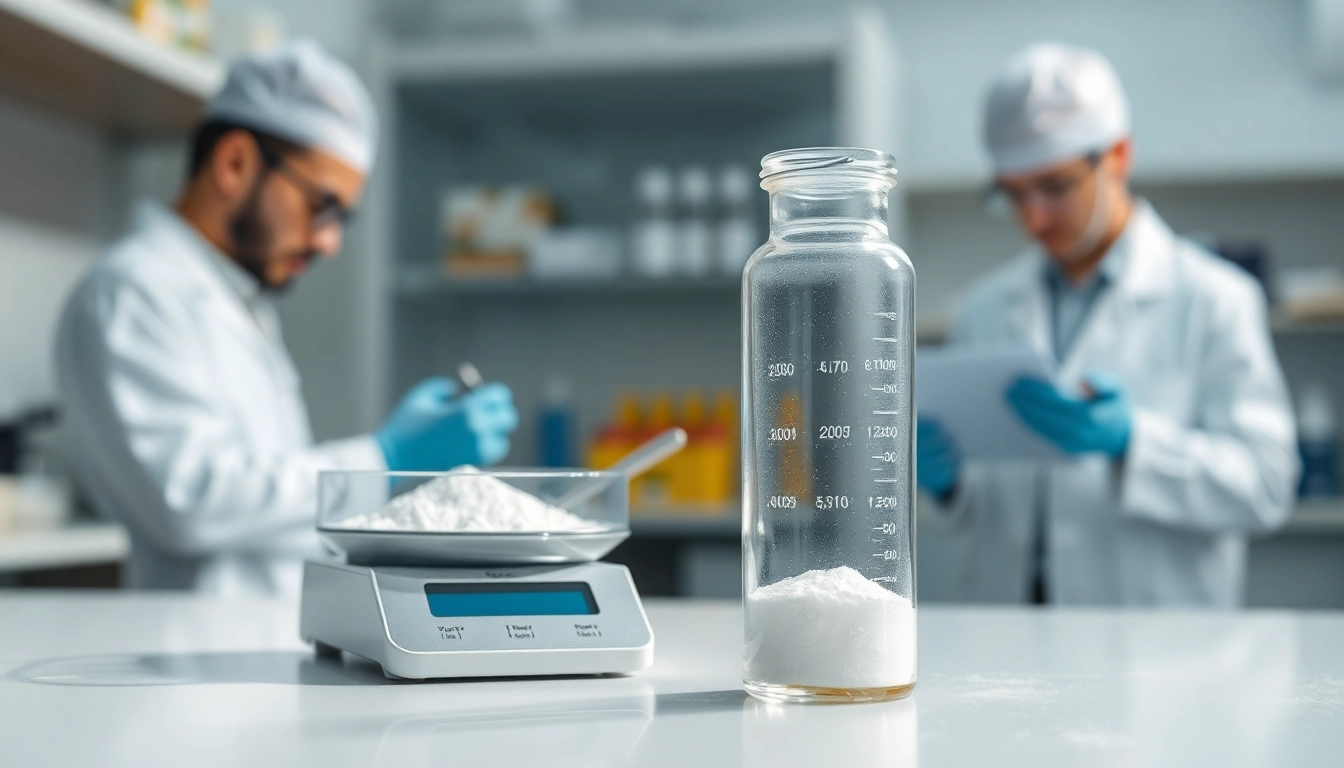Introduction to Hydroxypropyl Methylcellulose
Hydroxypropyl Methylcellulose (HPMC) is a versatile chemical compound with immense importance across various industries. Known for its unique properties, it plays a pivotal role in pharmaceuticals, food production, construction, and more. As a non-toxic, odorless, and tasteless white powder, it is derived from cellulose, which is an abundant natural polymer. The adaptability of Hydroxypropyl Methylcellulose makes it indispensable in numerous applications, helping to improve product quality and enhance user experience. For a comprehensive understanding of this compound, visit Hydroxypropyl Methylcellulose.
What is Hydroxypropyl Methylcellulose?
Hydroxypropyl Methylcellulose is a modified form of cellulose produced from natural sources. Cellulose is abundant in plant cell walls, and through a chemical process, HPMC is derived by substituting some of the hydroxyl groups in cellulose with hydroxypropyl and methyl groups. This modification enhances its solubility in cold water, a distinct feature compared to its raw cellulose counterpart. HPMC is utilized in a powdered form and easily converts into a gel-like substance upon mixing with water, making it a common ingredient in formulations that require thickening, binding, or emulsifying agents.
Chemical Properties and Structure
The chemical structure of Hydroxypropyl Methylcellulose comprises a backbone of cellulose with hydroxypropyl and methyl groups attached. These modifications not only enhance its solubility in cold water but also improve its thermal stability and hydrophilicity, making it advantageous for use in various formulations. HPMC is characterized by its molecular weight, degree of substitution, and the ratio of hydroxypropyl to methyl groups, which define its functional properties, including viscosity, gelling ability, and film-forming characteristics. The viscosity of HPMC solutions can be tailored by adjusting these parameters, which is critical for meeting specific application demands.
Historical Context and Market Evolution
The commercial use of Hydroxypropyl Methylcellulose traces back to the mid-20th century. Since then, it has seen remarkable growth in its applications. Initially developed for the pharmaceutical industry as a reliable excipient, its use has expanded significantly over the decades. Today, HPMC is a staple in many products, ranging from food additives to construction materials. The global market for this compound continues to evolve, driven by increased demand in emerging sectors and continuous innovation concerning its applications. Companies worldwide are investing in research to develop new and enhanced formulations that utilize HPMC, contributing to its growing significance in both established and novel industries.
Key Applications of Hydroxypropyl Methylcellulose
Use in Pharmaceuticals and Health Products
In the pharmaceutical arena, Hydroxypropyl Methylcellulose serves multiple roles. It is widely used as a binder in tablet formulations, helping to ensure that ingredients are properly mixed and hold together. Additionally, its excellent film-forming properties enable its use in coatings for tablets and capsules, which protect active ingredients from degradation and improve their stability. HPMC is also employed in producing controlled-release formulations, where it regulates the release of drugs over time, effectively enhancing therapeutic outcomes. Its safety profile, being non-toxic, makes it suitable for use in health products, including dietary supplements and vitamins.
Importance in Food and Drink Industries
Hydroxypropyl Methylcellulose has gained popularity in the food and beverage sectors due to its thickening and emulsifying properties. As a food additive, it is assigned the E number E464 and is utilized to improve texture, stability, and mouthfeel in various products. It provides viscosity and helps retain moisture in processed foods, which is crucial for prolonging shelf life. Additionally, HPMC is invaluable in gluten-free formulations, acting as a binding agent to enhance the texture of gluten-free bread and other baked goods. Furthermore, HPMC serves to create low-fat or reduced-calorie products by providing a rich texture without the additional calories associated with fats.
Role in Construction and Building Materials
The construction industry benefits substantially from the use of Hydroxypropyl Methylcellulose in a variety of products, including tile adhesives, joint compounds, and plaster mixes. Its ability to enhance water retention is vital for maintaining workability during the application of these materials. HPMC also improves adhesion and prevents the formation of cracks by allowing for better flexibility. As a binder, it plays a crucial role in ensuring that construction materials perform optimally under different environmental conditions. As the trend towards sustainable construction continues, the use of HPMC as an eco-friendly additive is gaining traction, promoting environmental responsibility while enhancing performance.
Benefits of Hydroxypropyl Methylcellulose
Improving Product Consistency
One of the primary benefits of Hydroxypropyl Methylcellulose is its ability to improve product consistency across various applications. In pharmaceutical formulations, for example, HPMC ensures a uniform distribution of ingredients, resulting in more reliable dosages. In food products, the stabilization and thickening properties of HPMC help maintain consistency and quality, irrespective of storage conditions. This uniformity not only improves product efficacy but also enhances consumer satisfaction, leading to repeat purchases and brand loyalty.
Enhancing Solubility and Stability
The enhanced solubility and stability of Hydroxypropyl Methylcellulose make it an attractive choice for formulators. Its unique hydrophilic nature enables fast dissolution in cold water, which is especially advantageous in applications where heating is not desirable. This solubility feature is vital in pharmaceuticals, allowing for the rapid release of active ingredients where needed. Furthermore, HPMC provides products with improved stability against environmental changes, such as temperature and humidity fluctuations, supporting extended shelf life and product integrity.
Environmental and Safety Considerations
Despite the myriad benefits of Hydroxypropyl Methylcellulose, environmental and safety considerations are paramount in its utilization. As a natural polymer, HPMC is biodegradable, contributing minimally to environmental burdens compared to synthetic alternatives. Its non-toxic nature makes it safe for a wide range of applications, appealing to both consumers and manufacturers focused on sustainability. Furthermore, the growing demand for environmentally friendly and non-toxic products across industries is driving increased interest in Hydroxypropyl Methylcellulose as a sustainable choice in manufacturing.
Best Practices for Using Hydroxypropyl Methylcellulose
Recommended Dosage and Mixing Techniques
Achieving optimal performance with Hydroxypropyl Methylcellulose relies heavily on proper dosage and mixing techniques. The amount of HPMC required depends significantly on its intended application, ranging from 0.5% for thickening agents in food to up to 20% in pharmaceuticals. It is crucial to mix HPMC with cold water slowly to prevent clumping. A high-shear mixer may be necessary for larger volumes to ensure uniform dispersion. Ultimately, conducting pre-formulation studies to determine the precise dosage for each application is highly recommended for effective outcomes.
Testing and Quality Control Measures
Quality control is vital when working with Hydroxypropyl Methylcellulose to ensure consistent performance and compliance with regulatory standards. Techniques such as viscosity measurements, pH testing, and solubility verification should be conducted regularly to guarantee product integrity. Manufacturers should also adhere to specifications provided for HPMC, including the degree of substitution and molecular weight, to ensure they meet the expected performance criteria. Implementing a robust quality management system can significantly decrease the likelihood of batch variability, leading to enhanced consumer confidence in the products.
Storage Solutions for Longevity
Proper storage of Hydroxypropyl Methylcellulose is essential for maintaining its effectiveness and prolonging its shelf life. HPMC should be stored in a cool, dry place, away from direct sunlight and moisture. Exposure to humidity can cause the product to clump or degrade, impacting its performance. Packaging should be airtight to minimize exposure to air and moisture. Regular inspections of stored HPMC are recommended to ensure its quality remains intact for use in formulations.
Future Trends and Innovations in Hydroxypropyl Methylcellulose Usage
Emerging Applications in New Industries
The future of Hydroxypropyl Methylcellulose usage is bright, with emerging applications in various industries on the horizon. The cosmetics and personal care sectors are beginning to recognize the benefits of using HPMC in formulations due to its stabilizing and thickening properties. Additionally, the recent interest in sustainable building materials has led to its application in bio-based construction solutions. Advancements in research may uncover further applications, particularly in biotechnology and green technologies, creating new avenues for HPMC in industries focused on sustainability and innovation.
Advancements in Production Techniques
As demand for Hydroxypropyl Methylcellulose grows, advancements in production techniques are underway. These innovations aim to enhance efficiencies, reduce costs, and improve the quality of the finished product. Technologies such as continuous processing, enhanced purification techniques, and the use of greener solvents are being explored. These advancements not only help in minimizing the environmental impact of HPMC production but also aim to ensure that products meet stringent regulatory requirements without compromising on quality. Continuous improvement in production methodologies will likely keep HPMC at the forefront of demand across various applications.
Impact of Regulations on Market Dynamics
Regulatory factors play a significant role in determining the market dynamics surrounding Hydroxypropyl Methylcellulose. As safety and environmental standards become increasingly rigorous, the industry must stay ahead by ensuring that all products containing HPMC comply with global regulations. Manufacturers are required to keep abreast of changes in laws governing the use of food additives, pharmaceuticals, and construction materials to mitigate risks associated with compliance failures. Ongoing dialogue with regulatory bodies and industry groups is essential to facilitate both innovation and market acceptance.






